| Overview | |
|---|---|
| Headquarters | Jacksonville, North Carolina |
| Reporting mark | CPLJ |
| Locale | Eastern North Carolina |
| Dates of operation | 1941–Present |
| Technical | |
| Track gauge | 4 ft 8 1⁄2 in (1,435 mm) standard gauge |
| Length | 5.5 miles (8.9 kilometres) |
Camp Lejeune Railroad, ( reporting mark CPLJ), is a shortline railroad that was a wholly owned by the Department of the Navy. The railroad operates over 25 miles (40 kilometres) of track that is owned by the U.S. Government with a trackage agreement to Norfolk Southern Railway for operations. A small 5.5 mile stretch between MCB Camp Lejeune and downtown City of Jacksonville, NC was abandoned in 1999 and turned over as part of Rails to Trails initiative. However the remaining Camp Lejeune Railroad from MCB Camp Lejeune to Havelock NC, 25 miles in total, is still active and owned by the US Navy.
Camp Lejeune Railroad began operations in 1941 to meet the needs for a track connecting the Marine Corps base with the Atlantic Coast Line Railroad in Jacksonville. A 5.5 mile section between the base and Jacksonville was hauling materials for the facility's construction and supplies for the Marines. The line serves as a point of access to the Marine Corps Air Station at Cherry Point and the port at Wilmington. [1]
In October 1999, the Camp Lejeune Railroad Company (CL) filed for abandonment of the 5.5 mile portion between Camp Lejeune and City of Jacksonville NC. [2] The abandonment was approved in December, which officially ended the railroad and operations from Marine Junction in Jacksonville to Camp Lejeune. [3] After abandonment, the railroad was converted to a rail-trail. [4]
A GE 65-ton switcher that served on the line at one time is preserved at the New Hope Valley Railway. The locomotive was acquired as surplus from the Department of Defense. [5]

The Norfolk Southern Railway is a Class I freight railroad in the United States, and is the current name of the former Southern Railway. With headquarters in Atlanta, Georgia, the company operates 19,420 route miles in 22 eastern states, the District of Columbia, and has rights in Canada over the Albany to Montréal route of the Canadian Pacific Railway, and previously on CN from Buffalo to St. Thomas. NS is responsible for maintaining 28,400 miles (45,700 km), with the remainder being operated under trackage rights from other parties responsible for maintenance. The most common commodity hauled on the railway is coal from mines in Indiana, Kentucky, Pennsylvania, Tennessee, Virginia, and West Virginia. The railway also offers the largest intermodal network in eastern North America.

The Florida East Coast Railway is a Class II railroad operating in the U.S. state of Florida, currently owned by Grupo México.
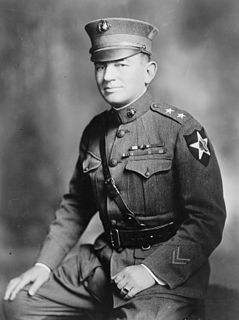
John Archer Lejeune was a United States Marine Corps lieutenant general and the 13th Commandant of the Marine Corps. Lejeune had nearly 40 years service in the Marine Corps including commanding the U.S. Army's 2nd Division during World War I. After his retirement from the Corps he was the superintendent of the Virginia Military Institute.

Marine Corps Base Camp Lejeune is a 246-square-mile (640 km2) United States military training facility in Jacksonville, North Carolina. The base's 14 miles (23 km) of beaches make it a major area for amphibious assault training, and its location between two deep-water ports allows for fast deployments.
U.S. Route 258 is a spur of US 58 in the U.S. states of North Carolina and Virginia. The U.S. Highway runs 220.15 miles (354.30 km) from US 17 Business and NC 24 Business in Jacksonville, North Carolina north to Virginia State Route 143 at Fort Monroe in Hampton, Virginia. In North Carolina, US 258 connects Jacksonville with the Inner Banks communities of Kinston, Snow Hill, Farmville, Tarboro, and Murfreesboro. The U.S. Highway continues through the Virginia city of Franklin, where the highway intersects US 58, and the town of Smithfield on its way to the Hampton Roads metropolitan area. US 258 crosses the James River on the James River Bridge and follows Mercury Boulevard through Newport News and Hampton.
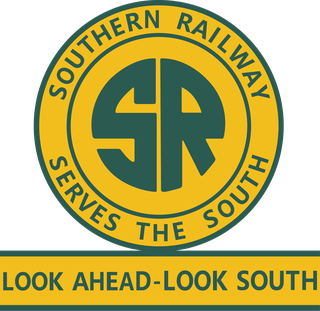
The Southern Railway was a class 1 railroad based in the Southern United States between 1894 and 1982, when it merged with the Norfolk & Western to form Norfolk Southern. The railroad was the product of nearly 150 predecessor lines that were combined, reorganized and recombined beginning in the 1830s, formally becoming the Southern Railway in 1894.

The North Carolina Transportation Museum is a museum in Spencer, North Carolina. It is a collection of automobiles, aircraft, and railway vehicles. The museum is located at the former Southern Railway's 1896-era Spencer Shops and devotes much of its space to the state's railroad history. The museum has the largest collection of rail relics in the Carolinas. Its Back Shop building of nearly three stories high is most notable for its size of two football fields long.
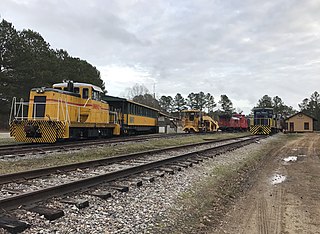
The New Hope Valley Railway is a heritage railroad in Bonsal, North Carolina operated by the North Carolina Railway Museum, Inc., an all-volunteer, nonprofit, and tax exempt educational and historical organization.

The Bay Coast Railroad operated the former Eastern Shore Railroad line from Pocomoke City, Maryland, to Norfolk, Virginia. The Bay Coast Railroad interchanged with the Norfolk Southern Railway at Norfolk, Virginia and the Delmarva Central Railroad at Pocomoke City, Maryland. Following the lease of 162 miles of Norfolk Southern track on the Delmarva peninsula by the Delmarva Central Railroad in December 2016, the interchange changed from NS to the DCR.

The Durham and Southern Railway operated 56.8 miles (91.4 km) of railroad from Dunn to Durham, North Carolina, USA. It was originally chartered as the Cape Fear and Northern Railway by Holly Springs resident George Benton Alford in 1892 and construction began in 1898. The name was changed to Durham and Southern in 1906. In 1979 it became part of the Seaboard Coast Line Railroad a predecessor to the CSX system. The tracks between Apex and Erwin Junction were removed in 1981 and the Dunn to Erwin segment was sold to the Aberdeen and Rockfish Railroad who operated it as a separate entity, the Dunn-Erwin Railway, until merging it into their operations in 1990. The closure of the cotton and denim mill in Erwin in 2000 led to the abandonment of these tracks and the conversion of the right-of-way to a rail trail. The Durham to Apex segment remains in use by CSX.
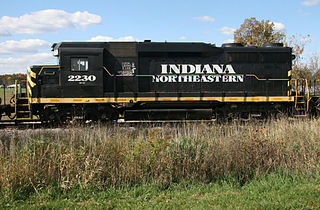
The Indiana Northeastern Railroad is a Class III short line freight railroad operating on nearly 130 miles (210 km) in southern lower Michigan, northeast Indiana and northwest Ohio. The Indiana Northeastern Railroad Company began operations in December 1992 and is an independent privately owned company. As of 2017 the railroad hauled more than 7,000 carloads per year. Commodities moved by the railroad include corn, soybeans, wheat and flour. It also handles plastics, fiberboard, aluminum, copper, coal, perlite, stone, lumber, glass, rendering products, as well as agricultural fertilizers and chemicals.
The Chillicothe–Brunswick Rail Maintenance Authority was a class III railroad that operated in north-central Missouri.
The North Carolina Railroad is a 317-mile (510 km) state-owned rail corridor extending from Morehead City, North Carolina to Charlotte, North Carolina. The railroad carries over seventy freight trains offered by the Norfolk Southern Railway and eight passenger trains daily. It is managed by the North Carolina Railroad Company and operated by Norfolk Southern.
Verona is a small town in rural Onslow County, on the outskirts of Jacksonville, North Carolina. It is located off of U.S. Route 17, seven miles (11 km) to the south of Jacksonville, and ten miles (16 km) to the north of Holly Ridge. Verona is bordered by Highway 17 to the east, Verona Rd. to the north, and High Hill Rd. to the South. High Hill Rd and Verona Rd. intersect to form the western boundary. The population of Verona in the 2000 census was approximately 178 people. The demographic breakdown was: Caucasian: 86%, Hispanic: 9%, African-American: < 5%, Other: < 2%.
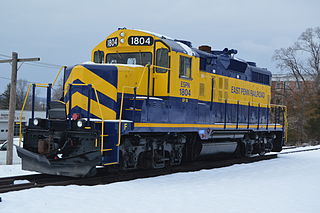
The East Penn Railroad is a short-line railroad that operates a number of mostly-unconnected lines in the U.S. states of Pennsylvania and Delaware. Except for two industrial park switching operations, all are former Pennsylvania Railroad or Reading Company lines, abandoned or sold by Conrail or its predecessors.
The Carolina & Northwestern Railway (Ca&NW) was a railroad that served South Carolina and North Carolina from 1897 until January 1, 1974. The original line was operated by the Ca&NW as a separate railroad controlled by the Southern Railway until 1974 when the name was changed to the Norfolk Southern Railway. On June 1, 1982, Southern Railway and Norfolk and Western Railroad merged to form Norfolk Southern Railway. Choosing to use the name 'Norfolk Southern Railway' for the merger, in 1981, the original Ca&NW line along with original Norfolk Southern Railway was renamed Carolina and Northwestern once again. In the early 1950s several shortline subsidiaries of the Southern Railway were leased to the Ca&NW for operation, with these lines remaining a part of the Ca&NW into the 1980s.

The Wabash Railroad was a Class I railroad that operated in the mid-central United States. It served a large area, including track in the states of Ohio, Indiana, Illinois, Iowa, Michigan, and Missouri and the province of Ontario. Its primary connections included Chicago, Illinois; Kansas City, Missouri; Detroit, Michigan; Buffalo, New York; St. Louis, Missouri; and Toledo, Ohio.
The Thermal Belt Railway is a Class III shortline railroad that operates for freight service on an irregular schedule on a former CSX line from Bostic to Forest City and on a former Norfolk Southern line from Forest City to Alexander Mills, North Carolina. Total mileage is 8.5 miles (13.7 km). Connections are made with CSX at Bostic. Rail is 85 pounds.
The Eastern Berks Gateway Railroad is a short-line railroad in Pennsylvania that runs from Boyertown south to Pottstown, where it interchanges with the Norfolk Southern Railway. The railroad was operated by U.S. Rail Partners until 2013, when the Colebrookdale Railroad Preservation Trust took over.
Atlantic and North Carolina Railroad Company was incorporated under act of the North Carolina Legislature, ratified December 27, 1852, and was organized on January 20, 1854.